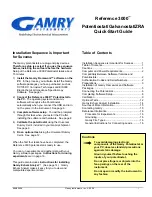
Programming examples
R&S
®
ZNA
1618
User Manual 1178.6462.02 ─ 20
// Save the complete Multi-Cal
:SENSe1:CORRection:COLLect:AUTO:SAVE
////////////////////////////////////////////////////////////////////////////////
8.2.5.3
Saving and recalling error terms
The following examples show you how to perform a system error correction, save the
acquired system error correction data to a file and reload them.
Performing a calibration, saving the error terms
// Reset the analyzer
*RST
:SYSTEM:DISPLAY:UPDATE ON
// Set frequency range
:SENSe1:FREQuency1:STARt 1GHz
:SENSe1:FREQuency1:STOP 4GHz
:SENSe1:SWEep:POINts 6
// Select calibration type: TOSM at ports 1 and 2
:SENSe1:CORRection:COLLect:METHod:DEFine 'Test SFK TOSM 12', TOSM, 1, 2
// Measure Standards
:SENSe1:CORRection:COLLect:ACQuire:SELected THROUGH, 1, 2
:SENSe1:CORRection:COLLect:ACQuire:SELected OPEN, 1
:SENSe1:CORRection:COLLect:ACQuire:SELected SHORT, 1
:SENSe1:CORRection:COLLect:ACQuire:SELected MATCH, 1
:SENSe1:CORRection:COLLect:ACQuire:SELected OPEN, 2
:SENSe1:CORRection:COLLect:ACQuire:SELected SHORT, 2
:SENSe1:CORRection:COLLect:ACQuire:SELected MATCH, 2
// Apply calibration
SENSe1:CORRection:COLLect:SAVE:SELected
// Save error terms
:FORMAT REAL,32
@TRACEFILE:scorr1.dat
:CALCulate1:DATA? SCORr1
@TRACEFILE:scorr2.dat
:CALCulate1:DATA? SCORr2
@TRACEFILE:scorr3.dat
:CALCulate1:DATA? SCORr3
// We are omitting the isolation term, as it is not implemented
// @TRACEFILE:scorr4.dat
Condensed programming examples
















































